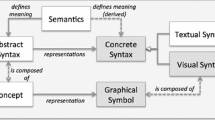Abstract.
The Visual Semantic Web (ViSWeb) is a new paradigm for enhancing the current Semantic Web technology. Based on Object-Process Methodology (OPM), which enables modeling of systems in a single graphic and textual model, ViSWeb provides for representation of knowledge over the Web in a unified way that caters to human perceptions while also being machine processable. The advantages of the ViSWeb approach include equivalent graphic-text knowledge representation, visual navigability, semantic sentence interpretation, specification of system dynamics, and complexity management. Arguing against the claim that humans and machines need to look at different knowledge representation formats, the principles and basics of various graphic and textual knowledge representations are presented and examined as candidates for ViSWeb foundation. Since OPM is shown to be most adequate for the task, ViSWeb is developed as an OPM-based layer on top of XML/RDF/OWL to express knowledge visually and in natural language. Both the graphic and the textual representations are strictly equivalent. Being intuitive yet formal, they are not only understandable to humans but are also amenable to computer processing. The ability to use such bimodal knowledge representation is potentially a major step forward in the evolution of the Semantic Web.
Similar content being viewed by others
References
Anderson JR, Bower GH (1973) Human associative memory. Winston, Washington, DC
Arnheim R (1969) Visual thinking. University of California Press, Berkeley, CA
Berners-Lee T (1998) What the Semantic Web can represent. http://www.w3.org/DesignIssues/RDFnot.html
Berners-Lee T, Hendler J (2001) Scientific publishing on the Semantic Web. Nature. http://www.nature.com/nature/debates/e-access/Articles/bernerslee.htm
Berners-Lee T, Hendler J, Lassila O (2001) The Semantic Web. Sci Am 284(5):34-43
Brachman R (1979) On the epistemological status of semantic networks. In: Findlee NV (ed) Associative networks: representation and use of knowledge by computer. Academic, New York, pp 3-50
Bray T, Hollander D, Layman A (1999) Namespaces in XML, World Wide Web Consortium Recommendation, 14 January 1999. http://www.w3.org/TR/REC-xml-names
Brickley D, Guha RV (2002) RDF Vocabulary Description Language 1.0: RDF Schema, W3C work in progress draft, 30 April 2002. http://www.w3.org/TR/rdf-schema
Chein M, Mugnier ML (1992) Conceptual graphs: fundamental notions. Rev Intell Artif 6(4):365-406
Corby O, Dieng R, Hebert C (2000) A conceptual graph model for W3C RDF. In: Proceedings of the international conference on conceptual structures (ICCS), Darmstadt, Germany, 14-18 August 2000. http://citeseer.nj.nec.com/cache/papers/cs/14625/ http:zSzzSzwww.int.gu.edu.auzSzkvozSzreadingzSz oliviericcs2000.pdf/dieng00conceptual.pdf
Cyc. OpenCyc.org (2002) http://www.opencyc.org/
Delteil A, Faron C (2002) A graph-based knowledge representation language. In: Proceedings of the 15th European conference on artificial intelligence (ECAI), Lyon, France, 21-26 July 2002
Delugach H (2003) Conceptual Graphs homepage. http://www.cs.uah.edu/~delugach/CG/
Dori D (2002) Object-Process Methodology - a holistic systems paradigm. Springer, Berlin Heidelberg New York. www.ObjectProcess.org
Dori D (2002) Why significant change in UML is unlikely. Commun ACM 45(11):82-85
Dori D, Reinhartz-Berger I, Sturm A (2003) OPCAT - a bimodal CASE tool for object-process based system development. In: Proceedings of the IEEE/ACM 5th international conference on enterprise information systems (ICEIS 2003), Angers, France, 22-26 April 2003, pp 286-291. www.ObjectProcess.org
Dublin Core Metadata Initiative (2002) http://www.dublincore.org/
Gaines BR, Shaw MLG (1995) Concept maps as hypermedia components. Int J Hum Comput Stud 43(3):323-361
Genesereth MR (1998) Knowledge Interchange Format. Draft proposal American National Standard (dpANS), NCITS.T2/98-004. http://logic.stanford.edu/kif/dpans.html
Lassila O, Swick R (1999) Resource Description Framework (RDF) model and syntax specification. W3C Recommendation, 22 February 1999. http://www.w3.org/TR/REC-rdf-syntax
Lehman F (ed) (1999) Semantic networks in artificial intelligence. Pergamon, Oxford, UK
Martin P, Eklund P (1999) Embedding knowledge in web documents: CGs versus XML metadata languages. In: Proceedings of the 7th international conference on conceptual structures (ICCS’99), Blacksburg, VA, 12-15 July 1999. Springer, Berlin Heidelberg New York
Mayer RE (2002) Multimedia learning. Cambridge University Press, New York
McTear MF (ed) (1998) Understanding cognitive science. Ellis Horwood, Chichester, UK
Novak JD (1977) A theory of education. Cornell University Press, Ithaca, NY
Novak JD, Gowin DB (1984) Learning how to learn. Cambridge University Press, New York
OMG UML1.4. Object Management Group (2001) Unified Modeling Language v.1.4, September 2001. http://www.omg.org/technology/documents/formal/uml.htm
OMG XMI. Object Management Group (2002) XML Metadata Interchange (XMI) specification v.1.2, January 2002. http://www.omg.org/technology/documents/formal/xmi.htm
Peirce CS (1932) Collected papers of Charles Sanders Pierce. In: Hartshorne C, Weiss P (eds) Harvard University Press, Cambridge, MA
Peleg M, Dori D (2000) The model multiplicity problem: experimenting with real-time specification methods. IEEE Trans Softw Eng 26(8):742-759
Pepper S, Moore G (2001) XML Topic Maps (XTM) 1.0. TopicMaps. Org Specification, 2001. http://www.topicmaps.org/xtm/1.0/
Smith MK, McGuinness D, Volz R, Welty C (2002) Web Ontology Language (OWL) Guide Version 1.0. W3C Working Draft, 4 November 2002. http://www.w3.org/TR/2002/WD-owl-guide-20021104/
Sowa JF (1984) Conceptual structures: information processing in mind and machine. Addison-Wesley, Reading, MA
Sowa JF (2000) Conceptual Graph Standard, 2000. http://users.bestweb.net/~sowa/cg/cgstandw.htm#Header\_44
Sowa JF (2002) The Common Logic Standard initiative. http://suo.ieee.org/email/msg08241.html
Sowa JF (1999) Knowledge representation: logical, philosophical, and computational foundations. Brooks Cole, Pacific Grove, CA
W3C RDF Validation Service (2003) http://www.w3.org/RDF/Validator/
Author information
Authors and Affiliations
Corresponding author
Additional information
Received: 14 December 2002, Accepted: 28 November 2003, Published online: 6 February 2004
Edited by: V. Atluri
Dov Dori: dori@ie.technion.ac.il
Rights and permissions
About this article
Cite this article
Dori, D. ViSWeb - the Visual Semantic Web: unifying human and machine knowledge representations with Object-Process Methodology. VLDB 13, 120–147 (2004). https://doi.org/10.1007/s00778-004-0120-x
Issue Date:
DOI: https://doi.org/10.1007/s00778-004-0120-x




